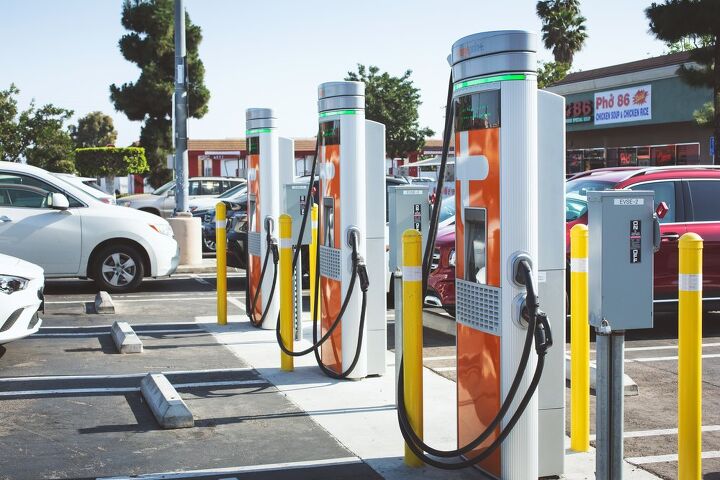EV Charging Networks Aren't Making Money

While the automotive sector is habitually discussing how electric vehicle adoption will be spurred on by the country building a more robust charging infrastructure, nobody seems to be talking about how to make charging profitable enough to sustain itself. As of now, government subsidies are helping to ease the financial burden of installing EV charging stations. But their long-term viability is being undermined by the fact that most people prefer charging at home.
This is largely unavoidable. One of the best features possessed by electric cars is their ability to recoup range while parked in the garage. But they likewise cannot become as useful as combustion-engine vehicles without the ability to recharge quickly on the go — hence the nationwide push to build more dedicated charging points.
Restaurants and retailers hoping to cater to specific demographics view having on-site charging as a major perk. It raises their profile and provides an opportunity to retain customers for a little longer as their EV takes on energy in the parking lot. This is seen as especially advantageous considering the present volatility of the economy.
But the deal does not appear to be so sweet for the companies that operate and maintain these networks. Surveys have shown that drivers are already broadly dissatisfied with the condition of most public charging stations. Maintenance seems to be subpar in a lot of instances and charger downtime has become a real issue for most providers that aren’t Tesla.
Considering that the income accrued by these networks is generally limited to what they make on charging fees, profitability is exceptionally limited when they’ve partnered with a local business that often leases out the space. Finding a healthy balance between charging rates that won’t infuriate drivers, but also ensure adequate incomes has proved difficult.
Automotive News perfectly encapsulated the dichotomy this week by reporting on just how much some networks have been struggling, while retailers reap comparably higher benefits:
ChargePoint posted a net loss of $344.5 million on revenue of $468.1 million for the fiscal year ended Jan. 31. EVgo, which runs more than 70 charging sites on [Simon Property Group locations], saw a net loss of $106.2 million on revenue of $54.6 million for the fiscal year ended Dec. 31. Blink Charging logged a net loss of $91.6 million on revenue of $61.1 million for the fiscal year ended Dec. 31.
"Charging economics is very, very challenging," said Akshay Singh, an automotive industries principal at [PricewaterhouseCoopers], about the networks installing stations at retailers and restaurants. "Nobody makes money right now."
Retailers and restaurants hosting chargers see revenue from increased spending at shops and on leases and other agreements from the networks. Networks' income from public charging is generally limited to what they make on fees.
The good news for these companies is that S&P Global Mobility anticipates that public charging will need to quadruple by 2025 in order to satiate demand. But they’ve been wrong about EV adoption rates in the past and there’s no guarantee that drivers won’t continue leaning upon home charging whenever possible.
In all likelihood, it’s the energy itself that will need the biggest overhaul in order to handle the elevated number of electric vehicles. That makes charging networks very existence beholden to government incentives.
Those are pretty robust at the moment. The National Electric Vehicle Infrastructure Formula Program has earmarked $5 billion for companies building EV charging infrastructure, and the 30C Alternative Fuel Infrastructure Tax Credit offers businesses a 30-percent tax write-off to install new charging stations. Meanwhile, states have funding schemes of their own — with Automotive News noting that Oregon is working on a rebate program that will give installers more than $4,000 for every public charging point installed.
Those cannot last forever and a lot of these companies are already operating at a loss. Unless additional revenue streams are implemented (e.g. converting stations to double as digital billboards), the only solution will be to raise charging rates. But doing that undermines some of the perceived benefits of owning an EV and may just encourage people to charge at home even more than they currently do.
[Images: The Image Party; Sundry Photography/Shutterstock]
Become a TTAC insider. Get the latest news, features, TTAC takes, and everything else that gets to the truth about cars first by subscribing to our newsletter.

A staunch consumer advocate tracking industry trends and regulation. Before joining TTAC, Matt spent a decade working for marketing and research firms based in NYC. Clients included several of the world’s largest automakers, global tire brands, and aftermarket part suppliers. Dissatisfied with the corporate world and resentful of having to wear suits everyday, he pivoted to writing about cars. Since then, that man has become an ardent supporter of the right-to-repair movement, been interviewed on the auto industry by national radio broadcasts, driven more rental cars than anyone ever should, participated in amateur rallying events, and received the requisite minimum training as sanctioned by the SCCA. Handy with a wrench, Matt grew up surrounded by Detroit auto workers and managed to get a pizza delivery job before he was legally eligible. He later found himself driving box trucks through Manhattan, guaranteeing future sympathy for actual truckers. He continues to conduct research pertaining to the automotive sector as an independent contractor and has since moved back to his native Michigan, closer to where the cars are born. A contrarian, Matt claims to prefer understeer — stating that front and all-wheel drive vehicles cater best to his driving style.
More by Matt Posky
Latest Car Reviews
Read moreLatest Product Reviews
Read moreRecent Comments
- Redapple2 All this BEV investment. A bigger impact (less oil consumption) would have been made if we had made PIG UP trucks smaller since 2000 and not HUGEr. (And raised gas tax by $2-3/gallon.)
- ChristianWimmer One of my clients is a company that is actually producing eFuels in Leipzig. Yes, they require a lot of energy to produce but this would not be an issue if Germany had nuclear energy or used the excess energy from wind and solar to produce these fuels. In such a scenario the energy losses wouldn’t really matter.Also, I am told that nations like Spain or the North African nations like Morocco or Tunisia could be ideal places to produce eFuels/Hydrogen due to their abundance of solar power. Again, the energy loses here would not matter since the energy used to produce these fuels is essentially “free”. If this path were pursued, Morocco and Tunisia could become wealthy nations and exporters of eFuels and Hydrogen. Countries with an abundance of solar or wind or hydro energy could be producing eFuels for their domestic consumption and export.Another argument which to me is irrelevant these days ist the poor thermal efficiency of ICE engines (25-35% gasoline, 40-45% diesel). One long trips with cruise control set to 130 km/h and even the occasional venture into the 180-200 km/h zone, my fully loaded (with my gear) A250 (2.0 4-cylinder 224-hp Turbo) can achieve an impressive gas mileage of 6 L / 100 km. That’s phenomenal - I am looking at six 1 liter bottles of water right now and that’s all my car needs to travel 100 km… amazing.So, I am a supporter of eFuels. I love internal combustion engines and if we want to use them in a climate neural way, then eFuels are a must. Also, to me every ICE car is way more sustainable and longer-lasting an an EV. Mazda, Toyota etc. are making the right move IMO.
- Blueice Once you infuse governmental unit regulation & [marketing] and taxpayerfunding, one knows quite well, dat the product or service isdestine to fail; which includes battery vehicles. Just axe yourself how revolutionary have your home batterydevices become ??? I am still waiting. after three decades, for a battery shaver whichonly requires charging two or three times per year.I am glad that I do not have a plug in Frau.
- Tassos Such a heavy breadvan on stilts, with so much HP, AND with ONLY 100 KWH Battery, I doubt if you will ever see 250 miles, let alone 300, under the best of conditions. In the winter, count on 150 miles range.And NO, it looks TERRIBLE. The only SUV that looks great is the RANGE ROVER.
- Tassos They sure are doing the right thing in the SHORT and MEDIUM term.As for the long term, in the long run, YOU'LL ALL BE DEAD, so WHO CARES.



































Comments
Join the conversation
Haven't seen anyone take note of the marketing strategy of your friendly neighborhood crack/meth/fentanyl dealer - accepting that a loss at first is crucial to get your customers hooked on the product.
With a long-haul business model like this, you're practically guaranteed to lose money right out of the gate. It's when both the weaker competitors are filtered out and the customer base is solidly established that the money comes. The trick is to have enough initial investment to last.
Hmm, look up Clock Tower shopping center in Herndon, VA. Two chargers in front of the Giant grocery store. One charger in front of Stone Cove Kitbar and EVgo charger near -shudders- Chuck E Cheese's. Will all three charging sites survive? Probably not. The ones in front of the grocery store make sense. The one at Kitbar makes sense, charge while enjoying some good food at full service restaurant. Zoom out the map and look at the sheer amount of chargers in this tech-heavy area.
Oddly VW of North America doesn't have a charger.